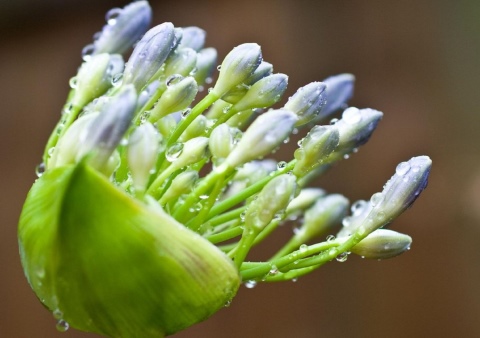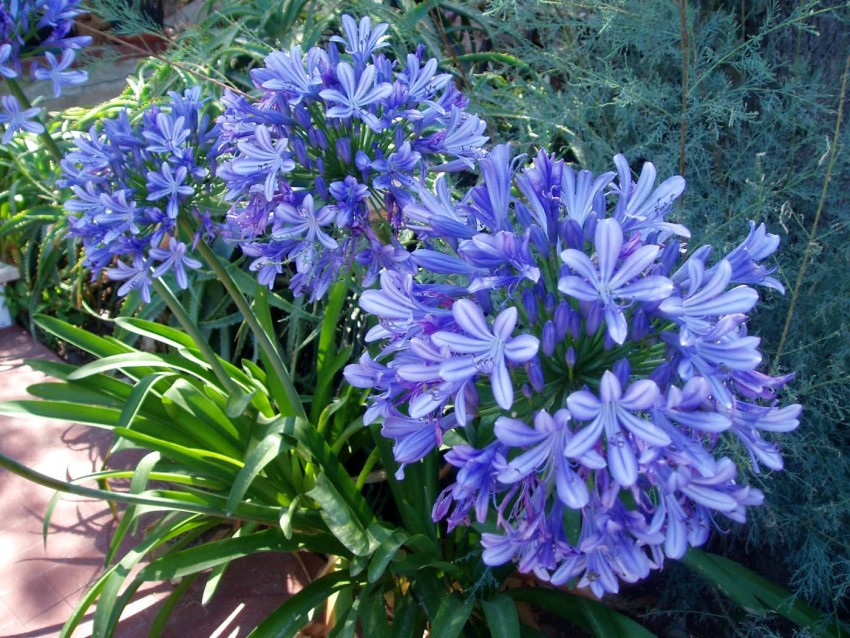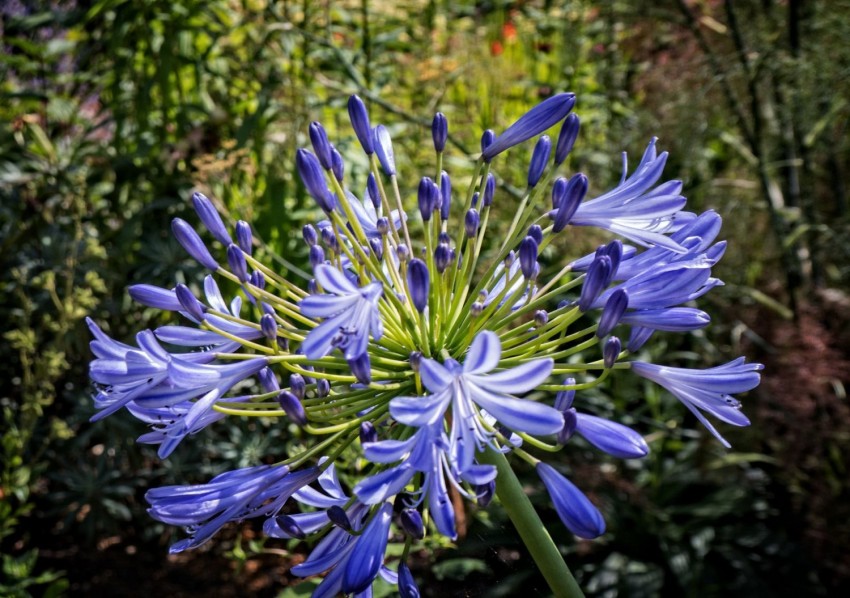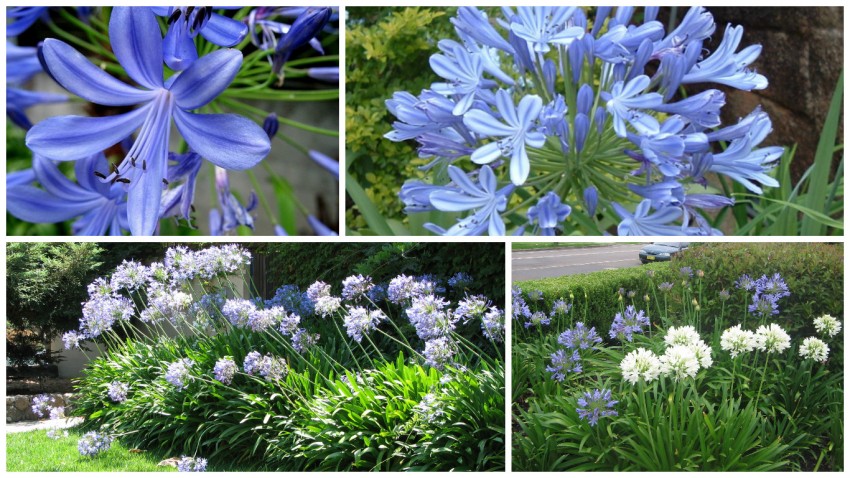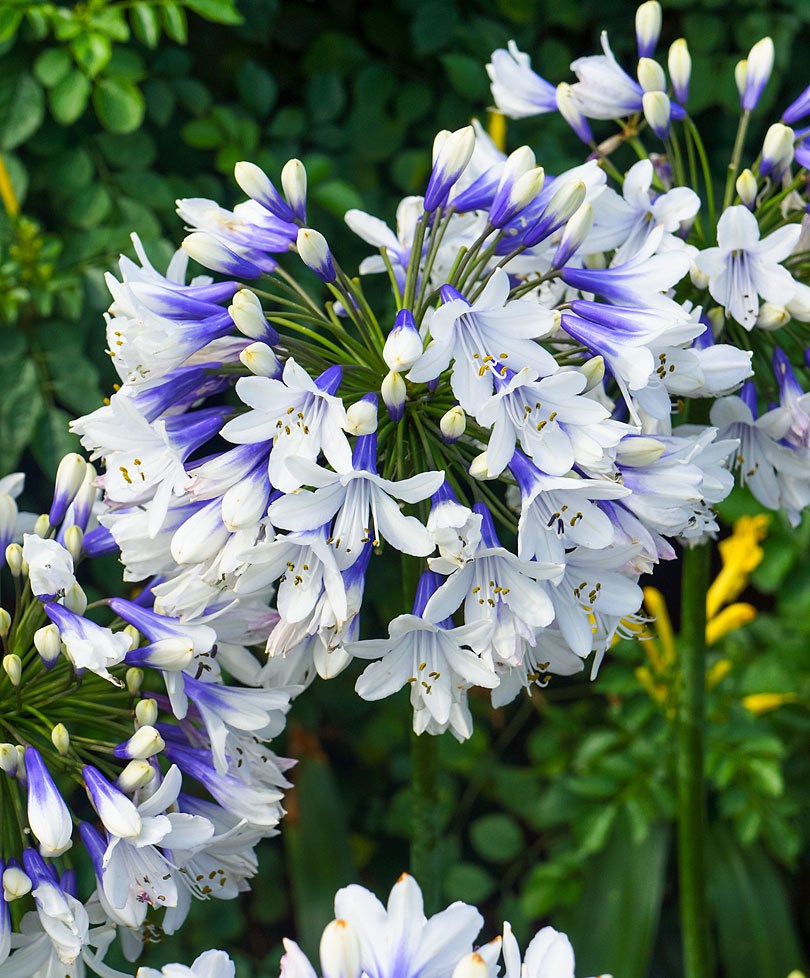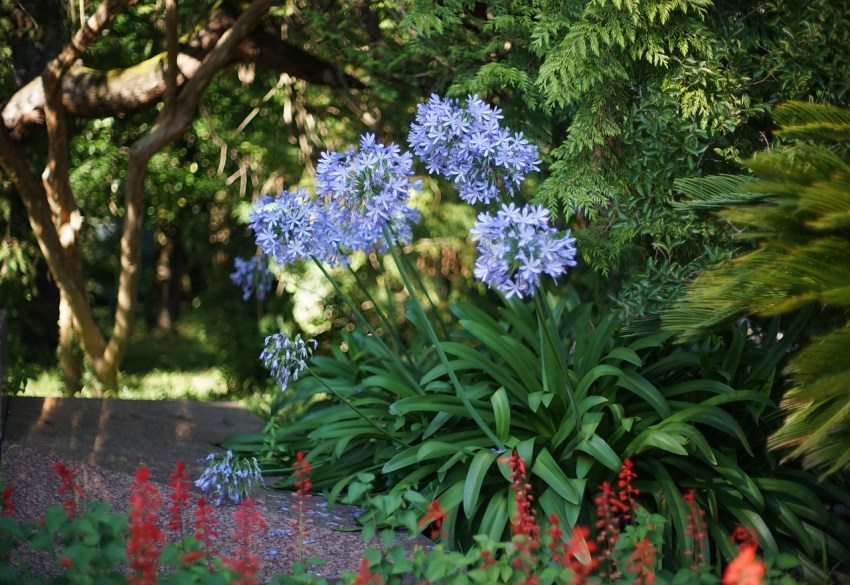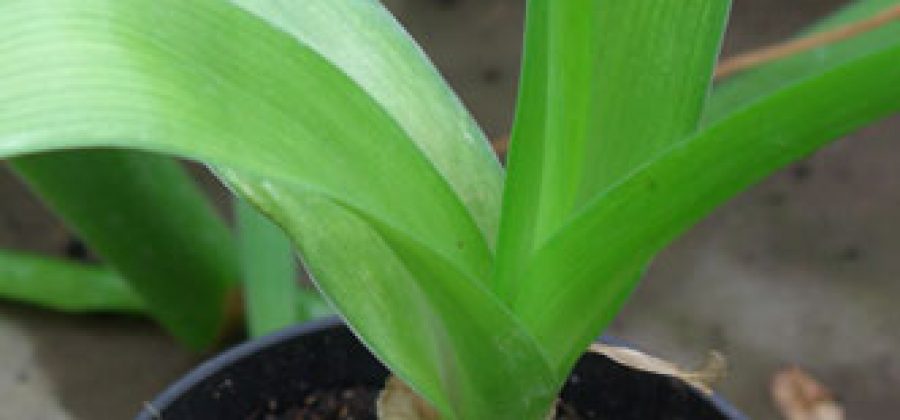What is this flower?
Agapanthus is native to South and Central Africa. The plant has a powerful rosette of dark green foliage in the shape of a belt and up to 50-70 cm long. It looks like a decorative ball. The fleshy root system is highly developed and is usually located in the upper layer of the soil.
By mid-summer, a strong round peduncle with a height of 40 to 150 cm protrudes from the outlet, at the top of which a dense spherical inflorescence is formed approximately 20-25 cm in diameter, formed from bell flowers on thin stems up to 5-6 cm long. white, blue, lavender with a dark central stripe. The flowering of the plant continues until late autumn.
After pollination, a capsule is formed with small, numerous dark, flat seeds.
Plant features
Long bloom (about two months !!) attracts gardeners. The flowers open gradually and emit a pleasant, unobtrusive aroma. Suitable for cutting, and stands well in a bouquet for more than two weeks, if you cut off the peduncle immediately upon opening the first bud. You can use a dried peduncle for a dry bouquet.
The flowers resemble miniature lilies. The petals are oval with a dark stripe in the middle. One peduncle can contain up to 150 inflorescences.
Its flowering, depending on the variety, falls in June-October. About a dozen varieties of agapanthus are known, ranging from evergreen to deciduous.
The flower is flexible and easy to select. They managed to get varieties with flowers of sky-blue, lilac-white, ink-colored and even striped.
The agrotechnics of a flower is simple, under appropriate weather conditions, it is unpretentious and grows well. However, it must be remembered that this is a thermophilic plant. It hibernates only in warm regions.
Growers in other colder regions dig up the plant for the winter and store it in pots in a cool room.
Agapanthus perfectly cleans the indoor air from bacteria, viruses, toxins, radionuclides.
However, you need to remember that this is a poisonous plant and take precautions when caring for it.
agapanthus
Agapanthus Umbrella - care:
Lighting:
Loves lit places. Light should be provided to the agapanthus to the maximum. Therefore, it is best to place a flowerpot with agapanthus. on the south window, or on the balcony where there is plenty of fresh air and light.
Temperature:
Agapanthus does not like high temperatures. He likes good lighting, but doesn't like the heat. Therefore, under the scorching sun, agapanthus will not last long. But in a well-lit place with a temperature of no higher than 25 degrees, it will feel great.
Watering:
From April to October, you need to ensure that the earth is constantly wet in the flowerpot. That is, regular watering is recommended. The leaf system of the agapanthus is quite powerful and fleshy and the plant is demanding on moisture.
Humidity:
Agapanthus does not need high air humidity. Therefore, you do not need to worry about agapanthus if you did the scheduled spraying with water today. In winter, watering is sharply reduced. Agapanthus is in a resting phase.
Top dressing:
Agapanthus is fed indoors, and this is how it is most often grown here, once every 2 weeks with complex mineral fertilizers.
Transfer:
Agapanthus does not tolerate transplantation well. Then it recovers for a long time and may not bloom. Therefore, if you have planted agapanthus in a pot that is permanent for it. Better the less disturb him. But the permanent flowerpot for the agapanthus should be spacious enough.
Reproduction:
Agapanthus reproduces in two ways: by seeds and by dividing the rhizome.As for the seed propagation method, I want to upset you, it will take 6-7 years from planting to the first flowering period. I don’t think that will suit you. Therefore, it will be easier and much faster and more efficient to divide the rhizome into the number of parts you need and calmly transplant the agapanthus into new flowerpots.
Description
Agapanthus (lat.Agapanthus; agape - love, anthos - flower) is a herbaceous perennial of the Agapantov family.
A plant with a fleshy rhizome that guarantees survival under unfavorable conditions. The leaves are simple, linear, dense, forming a rosette. Flowers on a long leafless peduncle (04-1.4 m) in an umbrella inflorescence. The color of the corollas varies from white to blue-purple, 5 cm in size, inflorescence of 20-200 pieces. Different varieties bloom from June to mid-October. Box fruits ripen one month after flowering.
In cut agapanthus remains fresh for 2 weeks, in a dry bouquet it retains its color.
Other names
Agapanthus is known by other names that indicate its meaning:
- Flower of Love.
- Love flower.
- African (Nile) lily.
- Abyssinian beauty.
Where it comes from, history of origin
The plant comes from the Cape region (South Africa). In nature, it grows on dry mountain slopes, on the coast. The native climate resembles the Mediterranean, with seasons-antipodes: in winter (June-August) precipitation, temperature 0-12C, summer (December-February) dry and hot + 25-35C.
The Abyssinian beauty was brought to Europe in the 17th century; today it is familiar to European countries with a mild climate. Introduced in the Soviet Union during the formation of arboretums and botanical gardens (50-60s of the last century).
Appearance
The plant attracts attention with large (up to 25 cm in diameter) openwork umbrellas of white, blue, blue, lilac color against the background of dense bright green of elastic leaves. Agapanthus blooms profusely and for a long time from early summer to autumn, forming 10-15 peduncles in one outlet.
Agapanthus blooms profusely and for a long time from early summer to autumn, forming 10-15 peduncles in one outlet.
Features of growing agapanthus on the site
Agapanthus in the open field can be grown by reproduction. There are three ways:
- seeds;
- dividing root rosettes;
- shoots.
From seed

Seeds for planting are harvested in the fall after the fruit has ripened
With this method, you must first grow seedlings. And the sowing is done in March. For this, wide boxes are prepared. A mixture of sand with peat or leaf humus, taken in equal proportions, is suitable as a soil.
They act as follows:
- First, the seeds are soaked for 2 hours in cool water.
- A drainage layer (2–4 cm thick) of expanded clay or brick chips is poured onto the bottom of the container, then the substrate is laid out and moistened.
- Seeds are evenly distributed without deepening and sprinkled with earth. After that, the surface is lightly slapped with a palm.
- Cover the box with foil or glass to create a greenhouse effect. The seedlings are placed on a well-lit windowsill protected from direct sunlight.
The optimum temperature for germinating seeds is 23–25 ° C. It is necessary to open the protection daily for spraying crops with water and airing. The first shoots hatch after 2 weeks, after which the glass (film) is removed. As soon as 4 leaves are formed, they begin to pick the seedlings with transplanting in separate cups. This usually happens in mid-May. 2 weeks before transplanting into open ground, the seedlings begin to harden: they are taken out into the fresh air every day, starting at one hour and gradually increasing the period to 10-12 hours.

When transplanting seedlings, try not to damage their roots.
Transplanting seedlings into the garden is planned for a time when the soil is fully warmed up and stable warm weather is established outside without night frosts. On the garden bed, the sprouts are planted in holes 8–10 cm deep and at a distance of 40–50 cm from each other. Then the planting is mulched.And if planted in a flowerpot, place 2-4 pieces. together
When working, it is important to be careful with the root system of plants, as it is easily damaged
By dividing the rhizome
Propagation of agapanthus by dividing the roots produced in early spring during transplantation or in autumn. This is done only with adult bushes and with a frequency of 1 time in 3-4 years.

Propagation of agapanthus by dividing the rhizome is acceptable only for adult plants
Sequence of steps:
- Dig up the plant, trying to remove the root ball completely.
- Shake it off the ground and cut it into several pieces with a sharp tool. Each division should have developed root shoots, growth buds and several leaves.
- Sections are treated with crushed activated carbon.
- The cuttings are wrapped in a damp cloth and left for 2-3 days, then they are planted in the ground.
The first days, the sockets are watered minimally, and after they are rooted, they produce full-fledged hydration.
By shoots
In an adult agapanthus, young shoots - daughters - are formed at the base of the rosette. They can be detached and planted separately, resulting in a full-fledged plant.
Only in this case they act extremely carefully so as not to injure the roots of the mother bush. Otherwise he will die
Planting and care in the open field
For the successful cultivation of Agapanthus in your garden plot, the following rules must be observed:
- Site selection, lighting. Agapanthus belongs to light-loving plants, so the place for its cultivation should be bright, sunny, but with a little shading, so that direct sunlight does not burn the plant. If Agapanthus is planted in the shade, then it will form long, with very thin peduncles. In this case, special supports will be required for them, as a result of which the decorative beauty of the plant will be lost.
- Soil composition. Since the plant prefers nutrient soil, before planting it, it is advisable to prepare the necessary nutrient mixture yourself, consisting of humus, clay-sod and leafy soil, as well as river sand (recommended proportions: 2: 2: 1: 1). In addition, it is necessary to make drainage from small pebbles or rubble under a fertile soil layer.
- Temperature conditions, preparation for winter. Agapanthus grows well in the garden in summer. However, the plant tolerates coolness well and can withstand air temperatures down to -12 ° C. If Agapanthus is left in the open ground for the winter, then it must be covered with a box, and covered with sawdust and leaves on top. But in order to avoid misunderstandings, it is better to remove the plant with soil in the cellar until spring.
- Watering. The plant is very fond of water, so it must be watered often and abundantly. Watering stops as soon as cold weather sets in. It is not recommended to spray Agapanthus leaves, as the plant perfectly tolerates dry air.
- Top dressing. They should be carried out during the growing season. Use mineral and organic fertilizers. Feed the plant throughout the growing season every 10 days, alternating mineral and organic fertilizers.
- Transfer. The plant does not tolerate transplanting from one place to another, so it should not be injured again. The transplant should be carried out only when it becomes necessary to divide the bush. This usually occurs in the 3rd year of growth.
- The procedure for dividing the bush, planting. It is carried out in autumn or spring - after flowering or before its onset. The bush is dug up, thoroughly cleaned of clods of earth. Delenka must necessarily contain 1-2 leaf rosettes. The cut must be done with a sharp, clean knife, and the wounds must be sprinkled with activated charcoal. It is not recommended to plant the cuttings directly into the ground. They must be covered with a damp substrate and left for 2-3 days. After that, Agapanthus is planted in a permanent place. Landing holes are being prepared, and the dividers are neatly placed in them.Watering during this time should be moderate.
- Diseases and pests. Agapanthus is disease resistant. Sometimes, with prolonged, excessive moisture, the roots can begin to rot, but since the rhizome of the plant has bactericidal properties, it partially protects itself.
Sometimes the plant can be attacked by scale insects and spider mites. To get rid of them, the bush must be treated with an insecticide solution.
Possible problems
Agapanthus has good immunity, so it rarely gets sick. However, if the plant is kept in a room with dry air, spider mites and scale insects can be found on it.
A soap solution should be used to combat parasites in the early stages. It is enough just to process a bush with it, and then rinse the flower under the shower. If the damage is serious, it is better to resort to insecticides.

Root rot can also be encountered when growing African blue lilies. But this is only possible as a result of prolonged flooding. To cope with the problem, it is recommended to remove the damaged areas of the roots and transplant the flower into a new pot. Also, improper watering can lead to yellowing of the leaves. To remedy the situation, you need to start following the recommendations for plant care.
There are also problems with flowering. They are usually the result of:
- incorrectly selected container volume;
- an excess of nitrogen fertilizers;
- planting bulbs too deep;
- lack of cool wintering.
Obviously, all difficulties can be caused by non-observance of tips on the content, which means that they are easy enough to avoid.

Agapanthus, due to its unpretentiousness and decorativeness, has long been one of the most beautiful indoor and garden plants. It looks great singly and in group plantings. It can also be used to make bouquets, because it is not for nothing that it is called the flower of love.
General description of the plant
The birthplace of agapanthus is South and Central Africa. Despite the fact that it is a tropical crop, it can be grown quite successfully at home. In nature, Agapanthus Patens grows near the roots of large trees. This habitat characterizes the botanical features of the culture (Figure 2).
When giving a description of the plant, the following features should be mentioned:
- The root system lies close to the surface. It is wide and quite fleshy, so the plant gets enough nutrients and moisture.
- The leaves are long, can reach 70 cm in length, are painted in a rich green color. The plates form a dense root rosette.
- When the plant ends flowering, a dormant period begins. At this time, the culture releases new leaves. As a result, with age, the bush becomes very voluminous and spreading.
- Agapanthus flowers grow on the top of the peduncle, and they do not bloom at the same time, so the bush looks beautiful for a long time. On average, the flowering period lasts from July to October.
In a flowerbed, agapanthus looks very exotic, but you should be prepared for the fact that the plant will need special care in the open field. Indoors, the culture does not require special care, and it is able to absorb heavy metals from the air.
 Figure 2. The crop can be grown in pots and open field
Figure 2. The crop can be grown in pots and open field
After flowering is complete, a seed box is formed on the plant, which can be used to grow a young plant.
Description and characteristics of agapanthus
In a herbaceous perennial with a branched root system, both flowers and leaves are decorative. Most agapanthus varieties are evergreen in warm climates. The plant belongs to a separate species Agapantovye. Its characteristics:
- the aerial part consists of peduncles and a root rosette of leaves;
- peduncle - fleshy, up to 1.5 m;
- leaves - belt-shaped, 50-70 cm long;
- root system - extensive, fleshy, creeping;

- the buds are united in round umbellate inflorescences 25-40 cm in size;
- flower shape - funnel, diameter - 5-6 cm;
- petal length - 3-5 cm, color - lilac, bright blue, blue, white;
- during flowering, about 100-150 buds appear and wither in one inflorescence.
Agapanthus is usually planted in a flower bed or outdoor garden. It looks good in border form, in decorative compositions with other plants. Especially with those that bloom in the first half of the season. The combinations can be appreciated in the photo.
Also, the flower can be cultivated in indoor conditions. This method is relevant for northern latitudes, where growing agapanthus in the open field is impossible. It is buried on the site except in the middle of summer, for 1-1.5 months. On the windowsill, the plant realizes its useful feature - it absorbs and removes heavy metals, cleans the air from microbes.
Plant species
Currently, various types of agapanthus are grown in the garden.
One of the species is the umbrella agapanthus (Latin Agapanthus umbellatus or Agapanthus africanus), also called the "Abyssinian beauty" or "African lily". This herbaceous plant can grow up to 70 cm in height. Among other subspecies, this plant stands out for the decorativeness of a dense rosette, in which smooth, belt-like, dark green leaves are collected, which taper at the ends. The African lily blooms in many blue funnel-shaped flowers, united in umbellate inflorescences. The flowering period is from June to July. Seeds ripen in 35-40 days.
Eastern agapanthus (lat.Agapanthus orientalis), also called early agapanthus eastern subspecies. It is a perennial evergreen with dense, broad-linear, curved leaves and grows up to 60 cm tall. In the umbrella-shaped inflorescence, up to 100 blue flowers are collected. The flowering period is July-August.
Agapanthus campanulate (Latin name - Agapanthus campanulatus), also called Agapanthus patens, grows naturally on the humid mountain slopes in South Africa. It is a deciduous, perennial plant with linear, erect leaves up to 15 cm long. The flowering period is July-August. Agapanthus campanulatus blooms with bell-shaped flowers of bright blue color.
Almost all types of agapanthus are easily crossed and therefore are rich material for breeding. In addition, hybrids can also be formed under free pollination, which makes it difficult to accurately identify varieties and species.
Agapanthus: flower description

Agapanthus: photo of flowers
Agapanthus has South African roots and belongs to the lily family, in the area of origin it grows quietly in the wild. Prefers shade from nearby trees, whose crown provides good protection from the scorching sun. The plant can otherwise be called the African lily, there are up to 10 varieties most suitable for growing at home.
Evergreen, herbaceous, bulbous, perennial plant. The Agapanthus plant looks very impressive against the background of the usual indoor flowers, exotic white or blue flowers add to the complete picture, and the period of active flowering is beyond imagination - the last month of spring - until mid-autumn, it all depends on the selected plant variety.
Agapanthus shrub grows small in height, thick, fleshy rhizome, narrow, elongated leaves, about 60 cm in size, begin to taper towards the tip, gathered in a dense rosette at the root base. The peduncle itself is without leaf plates, rather elongated, up to 0.7 m, large in size, form a ball. Small flowers of Agapanthus form a false umbrella up to 20 centimeters in diameter. This umbrella contains a huge number of blue-purple flowers, in some cases the color range changes to pink shades.Each flower in a peduncle blooms in turn, and the peduncles themselves are formed one after another throughout the entire flowering period. The fruits formed after flowering are formed into boxes. The main part of the plant is grown in open space and reaches a gigantic height, but today varieties adapted for indoor use have been bred, respectively, their growth is miniature, only up to 50 cm.










